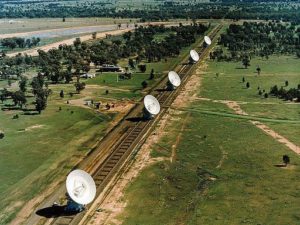
Image: This image of the Australia Telescope Compact Array, is credited to CSIRO, the Commonwealth Science and Industrial Research Organisation (Clayton South, Victoria, Australia), contributed by Psr1909 (Own work), via Wikimedia Commons.
The image contributor states:
Located near Narrabri in New South Wales, it can be linked to another antenna near Coonabarabran, and to the Parkes radio telescope. Such linking creates a virtual telescope hundreds of kilometers in diameter, able to see much more detail than any of the individual telescopes.
A virtual telescope, a fast-response system, and international cooperation made breakthrough discoveries possible.
A virtual telescope comprised of the Australia Telescope Compact Array radiotelescopes plus the Parkes radiotelescope was established as just a part of a larger network which included internationally distributed telescopes such as those at Arecibo, Puerto Rico, as well as the telescopes at Mauna Kea in Hawaii which have played a part in analyzing the 2015 repeated Fast Radio Bursts.
Now, thanks to the new study, we at least know where one of [the FRBs] came from. A flash detected on April 18 [2015] by the Commonwealth Scientific and Industrial Research Organization’s (CSIRO) 64-m Parkes radio telescope in Australia was tracked down to an elliptical galaxy around 6 billion light years away. The flash, known as FRB 150418, was pinpointed thanks to a quick-response-system set up by lead author Evan Keane and colleagues.
“In the past FRBs have been found by sifting through data months or even years later,” Keane, an astronomer with the Square Kilometer Array Organization, said in a statement. “By that time it is too late to do follow up observations.”
But these days, a ping on the Parkes radio telescope sets off a flurry of email alerts, allowing scientists to get straight to work.
“I was awoken by my phone going crazy a few seconds after it happened, saying: Evan, wake up! There was an FRB!” Keane told the BBC.
That allowed the team to turn immediately to the Australia Telescope Compact Array – and they were able to catch the FRB’s afterglow.
Then yet another telescope – the Subaru telescope in Hawaii – was used to image the source galaxy itself. Once they had an optical look at the host galaxy, they could use its light to calculate its distance.
To read the source article, visit WashingtonPost.com
Visit the next page to see what happened when the Japanese Subaru optical telescope in Hawaii honed in on the first set of repeated Fast Radio Bursts which occurred in 2015, as reported in February, 2016.
